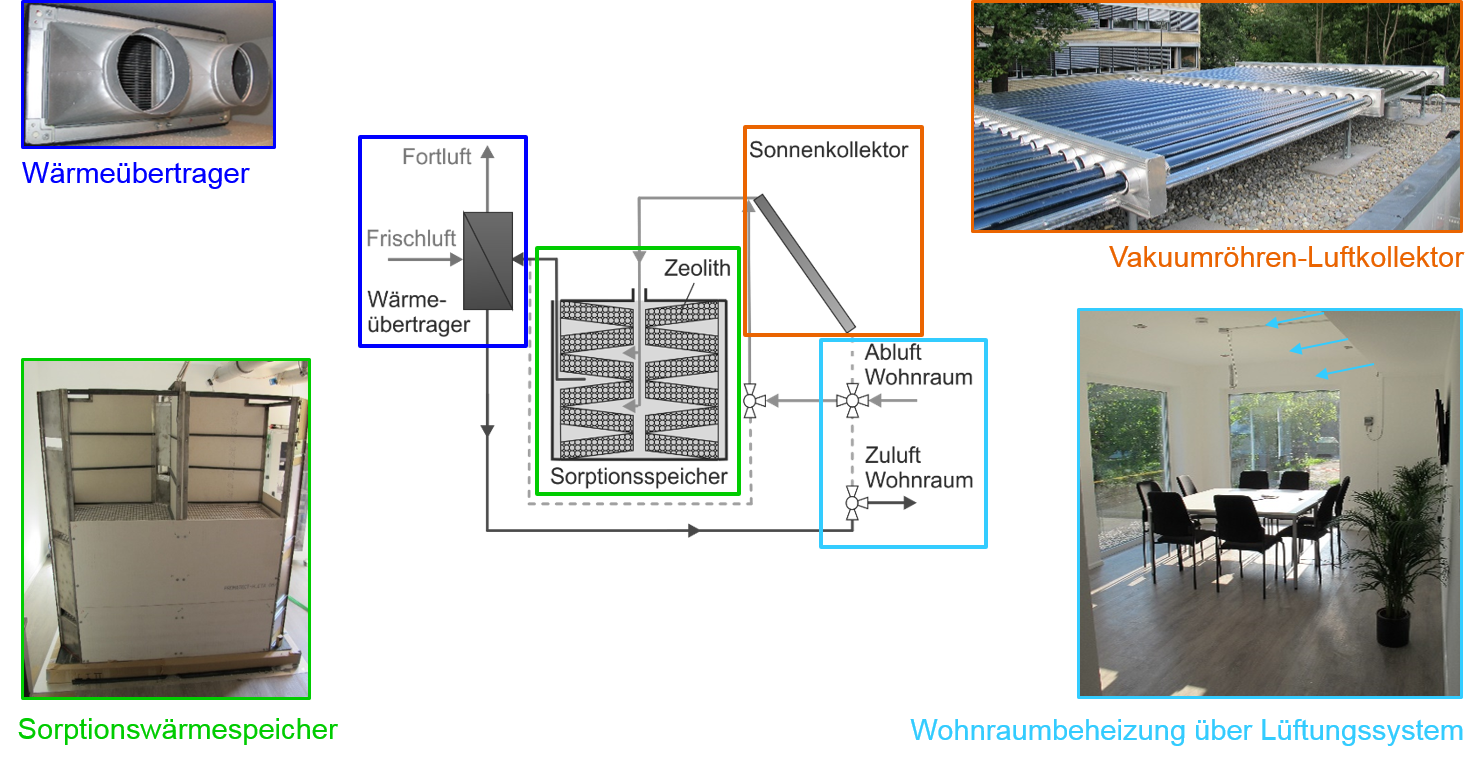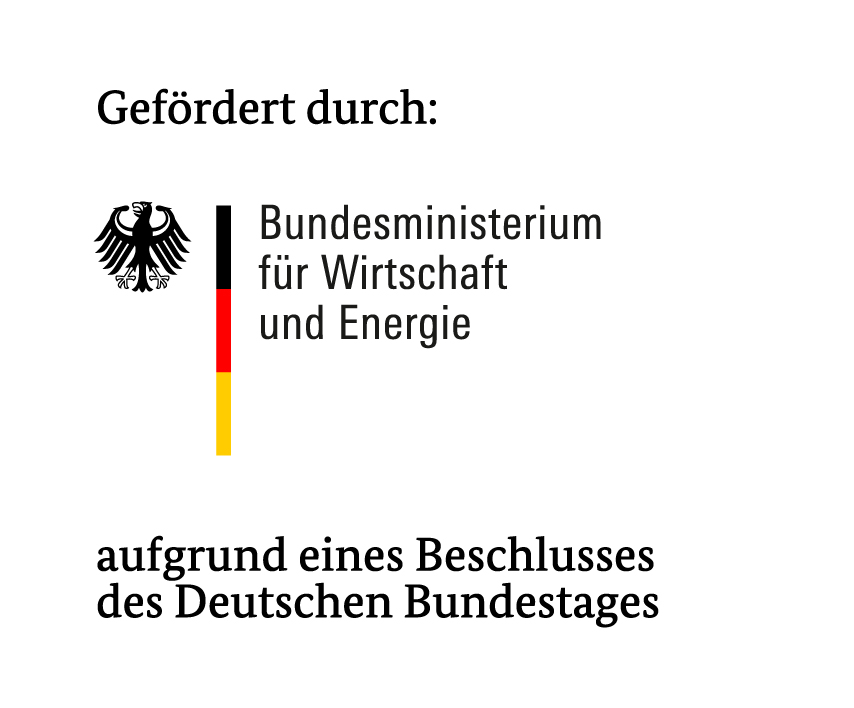Brief description
 |
In the previous SolSpaces project, a new solar heating system with sorption thermal energy store was developed and tested in a research building (see fig. 1). The purpose of the new heating concept is to cover the building’s thermal heat demand almost completely on a solar base via seasonal heat storage with the sorption thermal energy store. |
Fig. 1: SolSpaces research building on the campus of the University of Stuttgart
The components of the solar heating system are shown in fig. 2. Core of the heating system is the sorption thermal energy store where thermal energy is stored in summer in order to heat the building in winter. A vacuum tube air collector serves as heat source and is installed on the roof of the building. The building is heated by an air heating system. The heat of the exit air is recovered via a heat exchanger.
More details on how the solar heating system operates and about the construction and functionality of the sorption thermal energy store are available in the SolSpaces project description.

Fig. 2: Components of the solar heating system
The SolSpaces 2.0 project refers to the results of the first SolSpaces project and pursues the objective to further develop the solar heating system with a sorption thermal energy store. In the SolSpaces project, the base concept was completely realized and first operational experience was gained. Now, further conceptual optimization steps shall follow. Besides the dynamic testing of the newly developed solar heating system within a longer period of time, i.e. via several heating and regeneration phases, the technology shall be further optimized and simplified by innovative elements. One aspect to be analyzed is the reduction of the desorption temperature from currently approx. 180°C to approx. 130°C. By pre-drying the desorption air flow, an equal or even better desorption result can be achieved in spite of a lower desorption temperature. The low temperature regeneration makes it possible to use a broader range of cost-efficient solar collectors, especially flat plate collectors, and to simplify the hydraulic components of the system.
Furthermore, the combination of the thermal system with a photovoltaic plant offers interesting approaches regarding a combined thermal and electrical desorption; this shall be explored as well. In order to avoid superheating of buildings with extensive glazings, as active measures, the innovative heating concept is further developed towards a sorptive cooling system; as passive measures, switchable glazings are used for testing purposes. In order to identify further cost reduction potential, the store’s manufacturing process shall be analyzed and optimized from a production-related point of view. On this basis, implementation strategies are developed for the integration of the solar heating system into different building types for different climate zones.
Project duration
10/2016 – 09/2019
Project partners
Publications
- H. Kerskes, S. Bonk, R. Weber, H. Drück. Thermochemische Wärmespeicher für PV-Anlagen – Möglichkeiten zur effizienten Nutzung von Solarstrom für die Wärmeversorgung von Gebäuden, OTTI 32. Symposium Photovoltaische Solarenergie, 2017, Bad Staffelstein
- R. Weber, S. Asenbeck, H. Kerskes, H. Drück. SolSpaces – Erprobung eines solaren Heizsystems mit Sorptionswärmespeicher, OTTI 2. Fachforum Green Buildings – Innovative Gebäude und Quartiere mit erneuerbaren Energien, 2016, Frankfurt
- R. Weber, S. Asenbeck, H. Kerskes, R. Jaudas. SolSpaces – Entwicklung und Erprobung einer autarken solaren Wärmeversorgung für energieeffiziente Kompaktgebäude, Abschlussbericht, 2016
- Wärme bis zum Winter speichern, Projekt SolSpaces, BINE Informationsdienst, Energieforschung für die Praxis, 2016
- R. Weber, S. Asenbeck, H. Kerskes, H. Drück, SolSpaces – Testing and performance analysis of a segmented sorption store for solar thermal space heating, Energy Procedia 91 (2016) 250–258
- R. Weber, S. Asenbeck, H. Kerskes, H. Drück. SolSpaces – Konzept und Realisierung eines solaren Heizsystems mit Sorptionswärmespeicher, OTTI Fachforum Energieeffizienzhaus-Plus – Innovative Gebäude mit erneuerbaren Energien, 2015, Hamburg
- R. Weber, O. Barrena, H. Kerskes, H. Drück. SolSpaces – Entwicklung einer vollständig solaren Wärmeversorgung für energieeffiziente Kompaktgebäude – Erste Ergebnisse, Gleisdorf Solar, Tagungsband zur 11. Internationalen Konferenz für solares Heizen und Kühlen, 2014, Gleisdorf
- H. Kerskes, R. Weber, O. Barrena, H. Drück. Development of a segmented sorption store within the project SolSpaces, EuroSun, International Conference on Solar Energy and Buildings, 2014, Aix-les-Bains
- Die Sommerwärme bis zum Winter speichern, Projekt SolSpaces, BINE Informationsdienst, Energieforschung für die Praxis, 2014
Acknowledgements
The research project ”SolSpaces 2.0 – Further development and optimization of a solar heating system with sorption thermal energy store for complete heat supply of energy-efficient buildings” is funded by the Federal Ministry for Economic Affairs and Energy and by Project Management Jülich (German: Projektträger Jülich, PtJ) under grant number 0325868. The authors would like to sincerely thank for their support.


Contact

Dr.-Ing. Henner Kerskes
Team Lead

